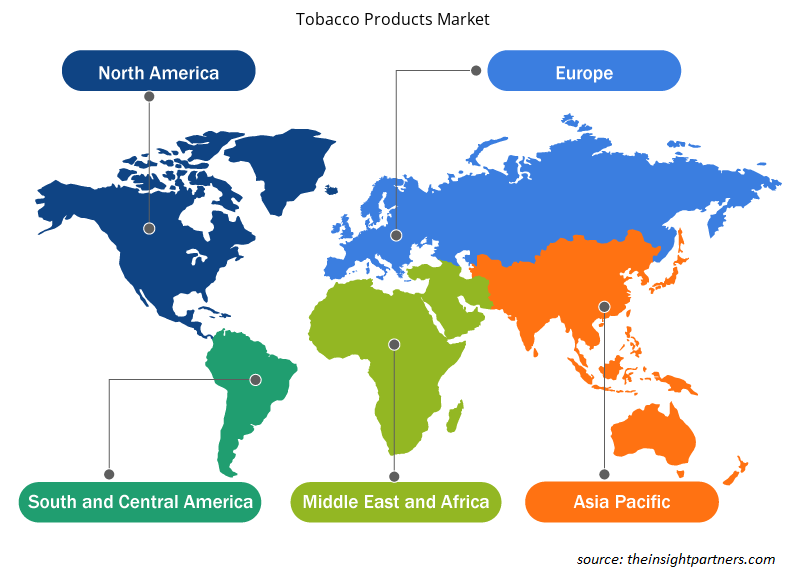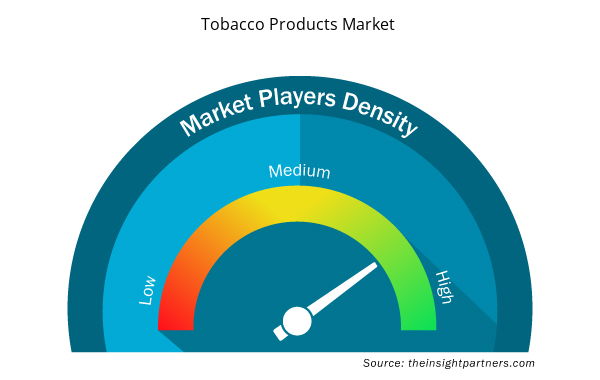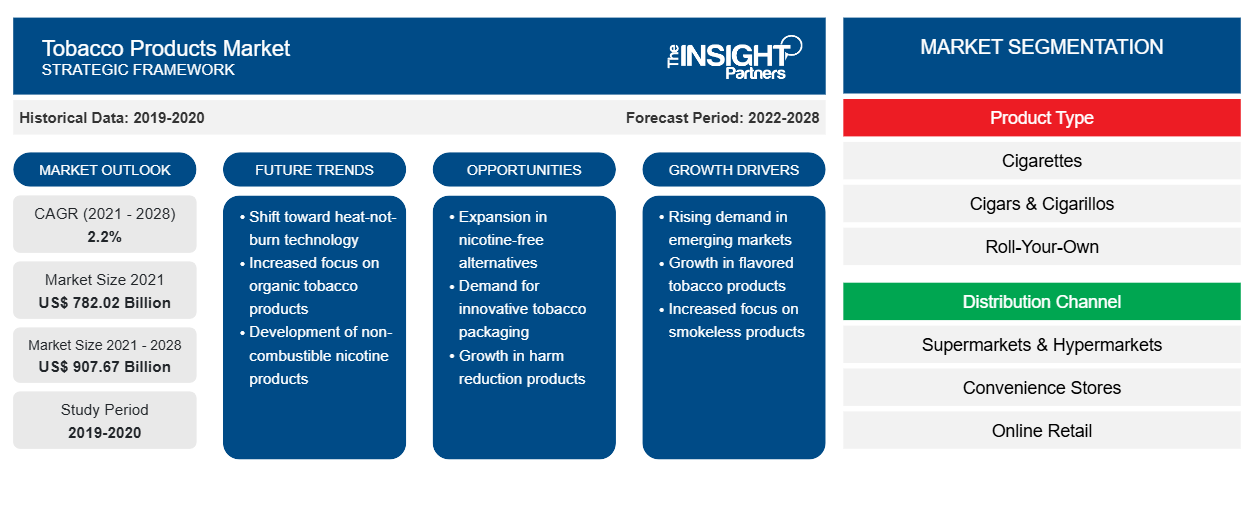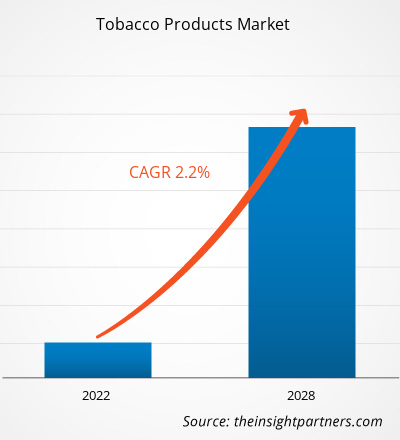Der Markt für Tabakprodukte soll von 782.022,19 Millionen US-Dollar im Jahr 2021 auf 907.665,43 Millionen US-Dollar im Jahr 2028 anwachsen. Von 2021 bis 2028 wird mit einer durchschnittlichen jährlichen Wachstumsrate von 2,2 % gerechnet.
Tabakblätter verschiedener Sorten, wie Virginia und Burley, werden gemischt, um Produkte wie Zigaretten , Zigarren und Zigarillos sowie Tabak zum Selbstdrehen herzustellen. Der Konsum von Tabak und verwandten Produkten stieg während der Zeit der wirtschaftlichen Rezession weltweit aufgrund von Börseneinbrüchen und Zwangsversteigerungen sowie dem Stress durch Entlassungen, der viele Menschen dazu veranlasste, Zuflucht im Rauchen zu suchen. Tabak ist eine der am häufigsten verwendeten Suchtmittel der Welt. Er trägt auch zum Großteil der Steuereinnahmen verschiedener Länder in Industrie- und Entwicklungsländern bei.
Der asiatisch-pazifische Raum hatte 2020 den größten Anteil am Markt für Tabakprodukte , während für den Nahen Osten und Afrika im Prognosezeitraum ein signifikanter CAGR auf dem Markt erwartet wird. Die wichtigsten Akteure auf dem Markt für Tabakprodukte weiten ihre Aktivitäten im Nahen Osten und in Afrika aufgrund des potenziellen Kundenstamms, günstiger Gesetze und einer sich in der gesamten Region schnell entwickelnden Einzelhandelslandschaft aus.
Passen Sie diesen Bericht Ihren Anforderungen an
Sie erhalten kostenlos individuelle Anpassungen an jedem Bericht, einschließlich Teilen dieses Berichts oder einer Analyse auf Länderebene, eines Excel-Datenpakets sowie tolle Angebote und Rabatte für Start-ups und Universitäten.
- Holen Sie sich die wichtigsten Markttrends aus diesem Bericht.Dieses KOSTENLOSE Beispiel umfasst eine Datenanalyse von Markttrends bis hin zu Schätzungen und Prognosen.
Auswirkungen der COVID-19-Pandemie auf den Markt für Tabakprodukte
Die COVID-19-Pandemie brachte Anfang 2020 für viele Branchen beispiellose Herausforderungen mit sich. Lockdowns, Grenzbeschränkungen, Reiseverbote, Produktionsunterbrechungen und andere Sicherheitsmaßnahmen, die von Regierungen gemäß den Richtlinien der WHO und der nationalen Gesundheitsministerien eingeführt wurden, behinderten die Produktionsabläufe. Andererseits waren laut Studien des American College of Physicians die Zigarettenverkäufe in den USA während der ersten 16 Monate der COVID-19-Pandemie höher als erwartet. Die Mehrheit der Tabakunternehmen verzeichnete während der Pandemie einen Anstieg der Nachfrage nach rauchfreien oder erhitzten Tabakprodukten und Kautabakprodukten. Aufgrund der Reiseverbote mussten sie jedoch einen leichten Rückgang der Einzelhandelsreiseverkäufe hinnehmen.
Markteinblicke
Steigende Nachfrage nach nicht brennbaren Tabakprodukten treibt Marktwachstum an
Aufgrund der zunehmenden gesundheitlichen Bedenken im Zusammenhang mit dem Konsum brennbarer Tabakprodukte haben Regierungen Unternehmen ermutigt, verschiedene Gesetze und Vorschriften einzuführen, um den Tabakkonsum unter Kontrolle zu halten. Sie haben die Steuern auf brennbaren Tabak erhöht und die Preise für nicht brennbaren Tabak gesenkt. Dies führte zu einer stärkeren Akzeptanz nicht brennbarer Produkte wie E-Zigaretten. So verfolgte die britische Regierung beispielsweise einen ganzheitlichen Ansatz, indem sie die Steuern auf brennbare Tabakprodukte deutlich erhöhte und die Steuern auf nicht brennbare Produkte senkte. Dies erhöhte die Akzeptanz von E-Zigaretten auf dem britischen Markt und reduzierte die Raucherquote im Land deutlich. Hersteller haben auch orale, nicht brennbare oder rauchfreie Tabakprodukte in der Kategorie der Produkte mit reduziertem Risiko (RRPs) entwickelt.
Einblicke in Produkttypen
Basierend auf dem Produkttyp ist der Markt für Tabakprodukte in Zigaretten, Zigarren und Zigarillos, selbstgedrehte Zigaretten und andere unterteilt. Das Segment der anderen Tabakprodukte wird im Prognosezeitraum voraussichtlich die höchste durchschnittliche jährliche Wachstumsrate verzeichnen. Dieses Segment umfasst E-Zigaretten, Vapes, Snus und lösliche Tabakprodukte. Das zunehmende Bewusstsein für die Gefahren brennbarer Tabakprodukte treibt die Nachfrage nach nicht brennbaren Tabakprodukten wie E-Zigaretten, Vapes und Kautabakprodukten an.
Einblicke in Vertriebskanäle
Basierend auf den Vertriebskanälen wurde der Markt für Tabakprodukte in Supermärkte und Hypermärkte, Convenience Stores, Online-Einzelhandel und andere segmentiert. Das Segment Online-Einzelhandel wird im Prognosezeitraum voraussichtlich die höchste durchschnittliche jährliche Wachstumsrate des Marktes verzeichnen. Der Online-Einzelhandel bietet den Benutzern ein bequemes Einkaufserlebnis, gefolgt von einer vereinfachten Produktlieferung. Online-Einzelhandelsgeschäfte bieten eine breite Produktpalette zu hohen Rabatten; außerdem können Verbraucher gewünschte Produkte bequem aus der Ferne kaufen. Hauslieferdienste ermutigen viele Verbraucher, über E-Commerce-Portale einzukaufen.
Zu den wichtigsten Akteuren auf dem Markt für Tabakprodukte zählen Altria Group, Inc.; British American Tobacco plc; Swedish Match AB; ITC Ltd.; Japan Tobacco International; Imperial Brands; Philip Morris Products SA; Vector Group LTD.; Pyxus International, Inc.; und China Tobacco International (HK) Company Limited. Diese Akteure entwickeln Produkte mit reduzierten Gesundheitsrisiken, um den neuen Verbrauchertrends gerecht zu werden und gleichzeitig die gesetzlichen Rahmenbedingungen einzuhalten. Sie sind an Fusionen und Übernahmen, Geschäftserweiterungen und Partnerschaften beteiligt, um ihren Marktanteil zu vergrößern.
Regionale Einblicke in den Markt für Tabakprodukte
Die regionalen Trends und Faktoren, die den Tabakwarenmarkt im Prognosezeitraum beeinflussen, wurden von den Analysten von Insight Partners ausführlich erläutert. In diesem Abschnitt werden auch die Marktsegmente und die Geografie von Tabakwaren in Nordamerika, Europa, im asiatisch-pazifischen Raum, im Nahen Osten und Afrika sowie in Süd- und Mittelamerika erörtert.

- Erhalten Sie regionale Daten zum Tabakmarkt
Umfang des Marktberichts zu Tabakprodukten
| Berichtsattribut | Details |
|---|---|
| Marktgröße im Jahr 2021 | 782,02 Milliarden US-Dollar |
| Marktgröße bis 2028 | 907,67 Milliarden US-Dollar |
| Globale CAGR (2021 - 2028) | 2,2 % |
| Historische Daten | 2019-2020 |
| Prognosezeitraum | 2022–2028 |
| Abgedeckte Segmente | Nach Produkttyp
|
| Abgedeckte Regionen und Länder | Nordamerika
|
| Marktführer und wichtige Unternehmensprofile |
|
Dichte der Marktteilnehmer für Tabakprodukte: Auswirkungen auf die Geschäftsdynamik verstehen
Der Markt für Tabakprodukte wächst rasant, angetrieben durch die steigende Nachfrage der Endverbraucher aufgrund von Faktoren wie sich entwickelnden Verbraucherpräferenzen, technologischen Fortschritten und einem größeren Bewusstsein für die Vorteile des Produkts. Mit steigender Nachfrage erweitern Unternehmen ihr Angebot, entwickeln Innovationen, um die Bedürfnisse der Verbraucher zu erfüllen, und nutzen neue Trends, was das Marktwachstum weiter ankurbelt.
Die Marktteilnehmerdichte bezieht sich auf die Verteilung von Firmen oder Unternehmen, die in einem bestimmten Markt oder einer bestimmten Branche tätig sind. Sie gibt an, wie viele Wettbewerber (Marktteilnehmer) in einem bestimmten Marktraum im Verhältnis zu seiner Größe oder seinem gesamten Marktwert präsent sind.
Die wichtigsten auf dem Markt für Tabakprodukte tätigen Unternehmen sind:
- Altria Group, Inc.
- British American Tobacco plc.
- Swedish Match AB
- ITC Ltd.
- Japan Tobacco International
Haftungsausschluss : Die oben aufgeführten Unternehmen sind nicht in einer bestimmten Reihenfolge aufgeführt.

- Erhalten Sie einen Überblick über die wichtigsten Akteure auf dem Markt für Tabakprodukte
Bericht-Spotlights
- Fortschrittliche Branchentrends auf dem Tabakmarkt helfen den Akteuren bei der Entwicklung wirksamer langfristiger Strategien
- Einführung von Geschäftswachstumsstrategien zur Sicherung des Wachstums in entwickelten und sich entwickelnden Märkten
- Quantitative Analyse des Tabakproduktmarktes von 2019 bis 2028
- Schätzung der weltweiten Nachfrage nach Tabakprodukten
- Porters Fünf-Kräfte-Analyse zur Veranschaulichung der Wirksamkeit der in der Branche tätigen Käufer und Lieferanten
- Aktuelle Entwicklungen zum Verständnis des wettbewerbsorientierten Marktszenarios
- Markttrends und -aussichten sowie Faktoren, die das Wachstum des Tabakproduktemarktes bestimmen
- Unterstützung im Entscheidungsprozess durch Aufzeigen von Marktstrategien, die das kommerzielle Interesse untermauern und zum Marktwachstum führen
- Größe des Tabakmarktes an verschiedenen Knotenpunkten
- Detaillierte Übersicht und Segmentierung des Marktes sowie der Dynamik der Tabakindustrie
- Ausmaß des Wachstums in verschiedenen Regionen mit vielversprechenden Wachstumschancen
- Historische Analyse (2 Jahre), Basisjahr, Prognose (7 Jahre) mit CAGR
- PEST- und SWOT-Analyse
- Marktgröße Wert/Volumen – Global, Regional, Land
- Branche und Wettbewerbsumfeld
- Excel-Datensatz


- Dried Blueberry Market
- Medical Enzyme Technology Market
- Cling Films Market
- Constipation Treatment Market
- Online Recruitment Market
- Smart Grid Sensors Market
- Electronic Toll Collection System Market
- Truck Refrigeration Market
- Quantitative Structure-Activity Relationship (QSAR) Market
- Pipe Relining Market

Report Coverage
Revenue forecast, Company Analysis, Industry landscape, Growth factors, and Trends

Segment Covered
This text is related
to segments covered.

Regional Scope
North America, Europe, Asia Pacific, Middle East & Africa, South & Central America

Country Scope
This text is related
to country scope.
Häufig gestellte Fragen
The global tobacco products market is primarily driven by the rising consumption of tobacco products in developing regions such as Asia-Pacific and the Middle East & Africa.
Based on product type, the other tobacco products segment is projected to grow at the fastest CAGR. Other tobacco products include e-cigarettes & vapes, snus, dissolvable, among others. The growing awareness about the hazardous effects of smoking among consumers is driving the demand for e-cigarettes, vapes, and snus.
Based on distribution channel, the supermarkets and hypermarkets segment held the largest market share owing to high customer traffic in these stores coupled with availability of different brands of tobacco products under one roof.
In 2020, Asia-Pacific led the global tobacco products market owing to the rising number of tobacco consumers across India, China, Japan, among other countries, changing lifestyles of people, increasing disposable income level, and easy available of different brands of tobacco products in the region
The tobacco products market is highly regulated. The manufacturers of tobacco products have to comply with stringent packaging and labeling regulations set by various regulatory bodies across different countries. Moreover, there are few yet dominant market players having strong distribution network and well-established customer base. Further, governments of different nations impose high duties on tobacco products to minimize their consumption. These are some of the entry barriers in the market.
Some of the prominent players operating in the global tobacco products market include Altria Group, Inc.; British American Tobacco plc; Swedish Match AB; ITC Ltd.; Japan Tobacco International; Imperial Brands; Philip Morris Products S.A.; Vector Group LTD.; Pyxus International, Inc.; and China Tobacco International (HK) Company Limited.
Trends and growth analysis reports related to Consumer Goods : READ MORE..
The List of Companies - Tobacco Products Market
- Altria Group, Inc.
- British American Tobacco plc.
- Swedish Match AB
- ITC Ltd.
- Japan Tobacco International
- Imperial Brands
- Philip Morris Products S.A.
- Vector Group LTD.
- Pyxus International, Inc.
- China Tobacco International (HK) Company Limited
The Insight Partners performs research in 4 major stages: Data Collection & Secondary Research, Primary Research, Data Analysis and Data Triangulation & Final Review.
- Data Collection and Secondary Research:
As a market research and consulting firm operating from a decade, we have published and advised several client across the globe. First step for any study will start with an assessment of currently available data and insights from existing reports. Further, historical and current market information is collected from Investor Presentations, Annual Reports, SEC Filings, etc., and other information related to company’s performance and market positioning are gathered from Paid Databases (Factiva, Hoovers, and Reuters) and various other publications available in public domain.
Several associations trade associates, technical forums, institutes, societies and organization are accessed to gain technical as well as market related insights through their publications such as research papers, blogs and press releases related to the studies are referred to get cues about the market. Further, white papers, journals, magazines, and other news articles published in last 3 years are scrutinized and analyzed to understand the current market trends.
- Primary Research:
The primarily interview analysis comprise of data obtained from industry participants interview and answers to survey questions gathered by in-house primary team.
For primary research, interviews are conducted with industry experts/CEOs/Marketing Managers/VPs/Subject Matter Experts from both demand and supply side to get a 360-degree view of the market. The primary team conducts several interviews based on the complexity of the markets to understand the various market trends and dynamics which makes research more credible and precise.
A typical research interview fulfils the following functions:
- Provides first-hand information on the market size, market trends, growth trends, competitive landscape, and outlook
- Validates and strengthens in-house secondary research findings
- Develops the analysis team’s expertise and market understanding
Primary research involves email interactions and telephone interviews for each market, category, segment, and sub-segment across geographies. The participants who typically take part in such a process include, but are not limited to:
- Industry participants: VPs, business development managers, market intelligence managers and national sales managers
- Outside experts: Valuation experts, research analysts and key opinion leaders specializing in the electronics and semiconductor industry.
Below is the breakup of our primary respondents by company, designation, and region:

Once we receive the confirmation from primary research sources or primary respondents, we finalize the base year market estimation and forecast the data as per the macroeconomic and microeconomic factors assessed during data collection.
- Data Analysis:
Once data is validated through both secondary as well as primary respondents, we finalize the market estimations by hypothesis formulation and factor analysis at regional and country level.
- Macro-Economic Factor Analysis:
We analyse macroeconomic indicators such the gross domestic product (GDP), increase in the demand for goods and services across industries, technological advancement, regional economic growth, governmental policies, the influence of COVID-19, PEST analysis, and other aspects. This analysis aids in setting benchmarks for various nations/regions and approximating market splits. Additionally, the general trend of the aforementioned components aid in determining the market's development possibilities.
- Country Level Data:
Various factors that are especially aligned to the country are taken into account to determine the market size for a certain area and country, including the presence of vendors, such as headquarters and offices, the country's GDP, demand patterns, and industry growth. To comprehend the market dynamics for the nation, a number of growth variables, inhibitors, application areas, and current market trends are researched. The aforementioned elements aid in determining the country's overall market's growth potential.
- Company Profile:
The “Table of Contents” is formulated by listing and analyzing more than 25 - 30 companies operating in the market ecosystem across geographies. However, we profile only 10 companies as a standard practice in our syndicate reports. These 10 companies comprise leading, emerging, and regional players. Nonetheless, our analysis is not restricted to the 10 listed companies, we also analyze other companies present in the market to develop a holistic view and understand the prevailing trends. The “Company Profiles” section in the report covers key facts, business description, products & services, financial information, SWOT analysis, and key developments. The financial information presented is extracted from the annual reports and official documents of the publicly listed companies. Upon collecting the information for the sections of respective companies, we verify them via various primary sources and then compile the data in respective company profiles. The company level information helps us in deriving the base number as well as in forecasting the market size.
- Developing Base Number:
Aggregation of sales statistics (2020-2022) and macro-economic factor, and other secondary and primary research insights are utilized to arrive at base number and related market shares for 2022. The data gaps are identified in this step and relevant market data is analyzed, collected from paid primary interviews or databases. On finalizing the base year market size, forecasts are developed on the basis of macro-economic, industry and market growth factors and company level analysis.
- Data Triangulation and Final Review:
The market findings and base year market size calculations are validated from supply as well as demand side. Demand side validations are based on macro-economic factor analysis and benchmarks for respective regions and countries. In case of supply side validations, revenues of major companies are estimated (in case not available) based on industry benchmark, approximate number of employees, product portfolio, and primary interviews revenues are gathered. Further revenue from target product/service segment is assessed to avoid overshooting of market statistics. In case of heavy deviations between supply and demand side values, all thes steps are repeated to achieve synchronization.
We follow an iterative model, wherein we share our research findings with Subject Matter Experts (SME’s) and Key Opinion Leaders (KOLs) until consensus view of the market is not formulated – this model negates any drastic deviation in the opinions of experts. Only validated and universally acceptable research findings are quoted in our reports.
We have important check points that we use to validate our research findings – which we call – data triangulation, where we validate the information, we generate from secondary sources with primary interviews and then we re-validate with our internal data bases and Subject matter experts. This comprehensive model enables us to deliver high quality, reliable data in shortest possible time.


 Holen Sie sich ein kostenloses Muster für diesen Bericht
Holen Sie sich ein kostenloses Muster für diesen Bericht